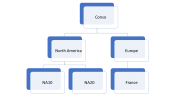Reporting Trees
The Reporting Tree feature provides you with a fast and flexible way to build financial Reports based on the structure and hierarchy of your company.
Although the main function of the Reporting Tree is the creation of financial Reports, it can be used in any other functional areas of your business (Sales, Logistics, Manufacturing, etc.). This allows you to build complex hierarchies composed of interrelated business units such as Departments, Cost Centers, Territories, and more.
This hierarchy is built through groups of Nodes that represent an organizational chart, in which each box defined reflects a user-defined context that rolls-up in a hierarchical way.
Let’s say that your company (the headquarters) has its departments located in different countries and that these departments have their own subsets.
In this example, Conso is the name of the headquarters (and because we plan to consolidate data in this report), North America and Europe are the location of the departments, NA10, NA20 and France are their subsets (children).
Thanks to the Reporting Tree, you do not need to manually create a Filter for each subset (NA10, NA20, France). The parent folder (Group Node) simply uses the filter data contained in its children (Filter Node).
By selecting a Node (Filter), you can then view your Reports in a variety of ways, all from one place. The same logic applies when distributing the Reports; it will generate all the required versions of your Reports based on your hierarchical configuration in a single output.
